Stone fence: design features and beautiful design options
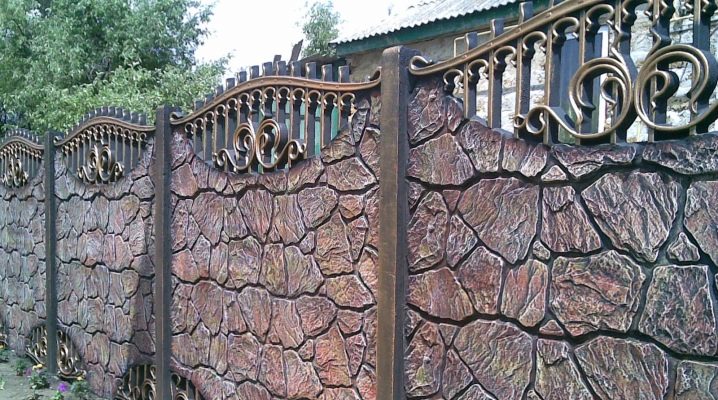
It’s safer to live behind a secure wall. And if she is also beautiful, there is no price to such a barrier from the outside world. There can hardly be anything more irresistible than a wall of stone.
There are a lot of materials for stone fences, as well as possible options for the execution of such fences. Before deciding which stone to build a "barrier wall" from, what technology to use for the construction, you need to properly understand this issue.
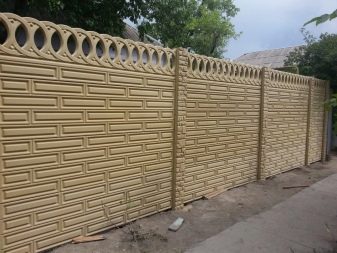
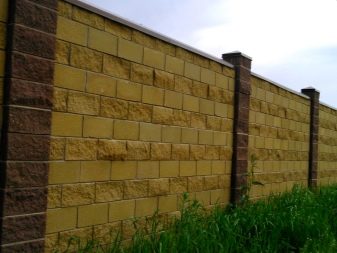
Peculiarities
A stone fence built with intelligence and thoroughness will last for a hundred years, or even more. There are many examples in history.
This is not the only advantage of such a fence:
- Stone is a natural material, therefore it is safe in an ecological sense, and some species have beneficial properties, such as shell rock, the presence of which has a positive effect on health.
- It is a non-combustible material that will be an excellent obstacle to a spreading fire.
- As a rule, such a fence is easy to install.
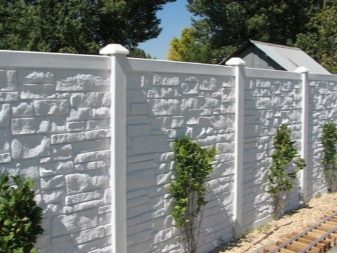
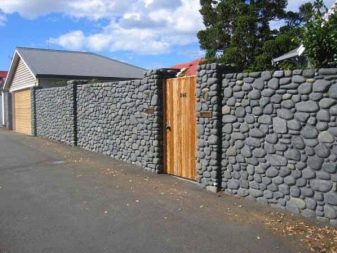
- To create a fence, you can choose a stone, the cost of which will not hit your pocket hard, since the price gap for material from certain rocks is significant.
- The stone blends harmoniously with other materials and fits perfectly into any landscape.
- A stone fence is suitable for fencing anywhere - in the city, in the village, in the country.
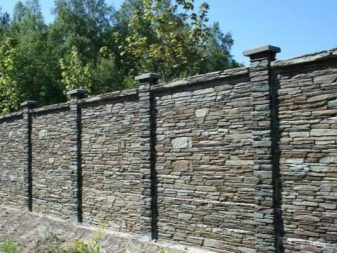
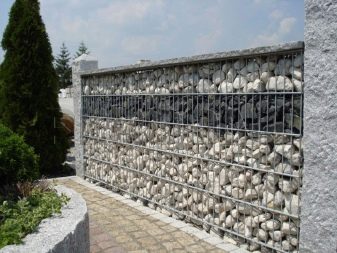
These fences also have their drawbacks. The construction of such a fence - from stone in a grid or from panels, for example, takes time. A stone fence can be significantly more expensive than wood or metal. Only the transportation of material can result in a significant amount. For example, the well-known Mekegin stone in some particular case will be unprofitable to choose for this reason.
Although it is still possible to find a way out and build a stone fence, so as not to go broke.
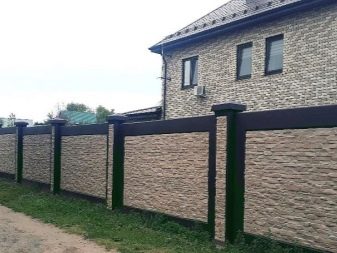

Types of stone
When you see a stone fence, certain associations come to mind. For example, England with its medieval castles and walls. A stone fence is always strength and steadfastness.
In order for the fence to make just such an impression, you can choose a really solid material, or you can be satisfied with a decorative option that can look no less impressive.
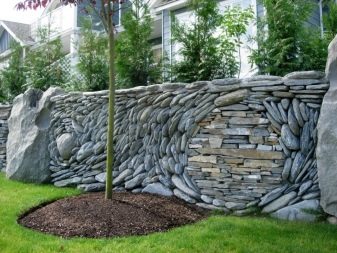
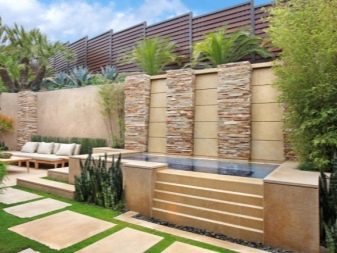
The most popular materials for the construction of stone fences are:
- Cobblestone. This is a fairly affordable stone, at the same time very durable. It is also called boulder. Not everyone likes the common gray color of this stone. You can also choose red-brown;
- Gravel. Has various factions. Thanks to this, you can make any kind of fence. An interesting result is obtained by combining small and coarse gravel. A metal frame can be filled with such a stone, and a reliable fence will be obtained. Also gravel combines well with bricks;
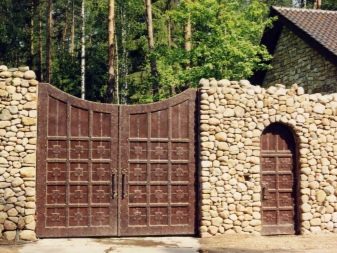
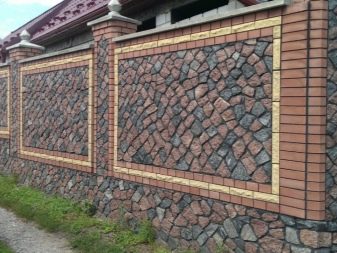
- Dolomite stone. It is flat in shape. Fences from it are very durable. Dagestan stone is popular among dolomites;
- Limestone. Limestones of white, light gray, yellowish tint, sometimes pinkish are found. In structure, they are dense, porous and marbled. Slabs for external and internal cladding are made from dense limestone. Porous varieties include, for example, shell rock. The name of this stone speaks for itself.The source of its origin is shells - shells of mollusks or their fragments. Shell rock is used both as a building material and as a decorative material;
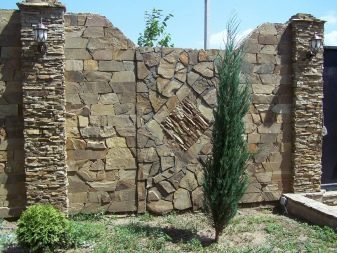
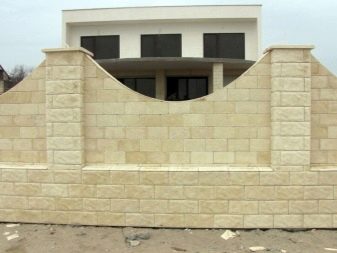
- Sandstone. It has long been used to create fences, as it is highly durable, resistant to frost and moisture;
- Booth. It is mined from sandstone, limestone and dolomite. These stones can vary greatly in size and are irregular in shape. Such material is used both directly for construction and as a facing. In color, it can be black or white, as well as yellow and blue.
The so-called wild stone is often used. It has a unique pattern, uneven surface and irregular shape resulting from the splitting of rocks. Designers use these properties when creating fences, among other things.
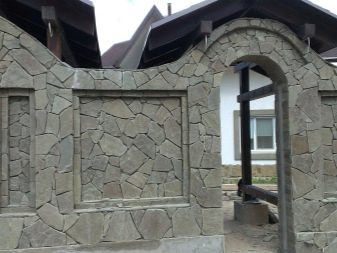
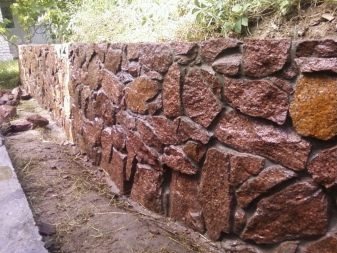
Artificial stone is a worthy substitute for natural in the modern world. Basically, concrete is used for its production, giving it the desired color with the help of special pigments. Outwardly, such material may not differ from natural.
An example of this is fences made of French stone. At their core, they are cinder blocks, empty inside. They are created using vibropressing. After that, they are treated with a special compound that prevents the penetration of moisture into the material. The Frenchman is distinguished by a large number of colors, has a small weight compared to natural stone and has standard sizes.
Well, if you want to have a stone fence, but for some reason you can't afford it, you can even make a fence made of siding with a stone pattern.
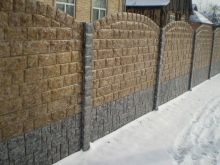

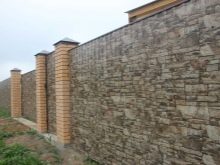
Constructions
Stone fences are very diverse in their design. This is due to the peculiarities of the very rocks of the stone used in construction, and to the constructive findings that are used when creating such fences.
So, for example, they create ragged sandstone fences. These are slabs of different thicknesses and shapes. The stone is uneven, with ragged edges and strong variations in thickness. It is laid randomly, fastened with a cement mortar. The slabs are adjusted to each other using a hammer. To do this kind of work, no special qualifications are required. It is enough to be able to hold a trowel in your hands.
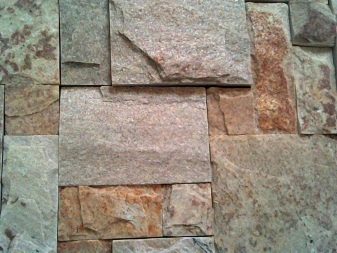
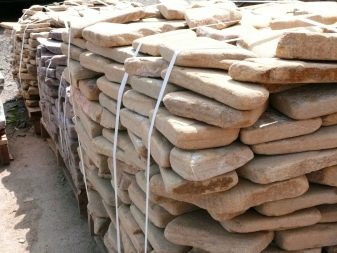
To make the fence look unusual, it is recommended to lay it out with stones that differ significantly in size from each other, including the smallest ones. Very large stones are not used in construction, since they are difficult to transport and handle.
On the market you can also find special blocks of the "torn stone" typeused to create fences. Blocks are made from sand, cement, special additives, dyes and fillers. They are created under the influence of high pressure and vibration. This allows you to achieve the strength and durability of the material. Outwardly, it is difficult to distinguish it from natural torn stone. But laying out a fence is much easier.
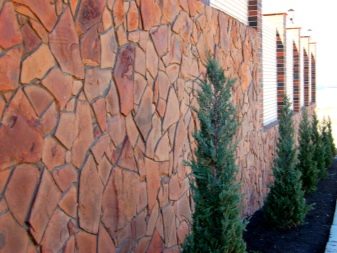
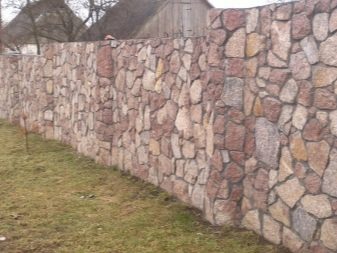
An interesting technology for creating stone fences called "gabion" came to us from Europe. This is the so-called bulk fence, when metal boxes are filled with stone, acting as a fence. Their profile is different.
The filler is usually crushed stone or pebbles. Although another stone can be used.
The shell fence will be almost eternal. It is an environmentally friendly, fireproof, natural material with a lower cost compared to other types of stone for the construction of fences.
You can choose from pastel shades of shell, gray or white.
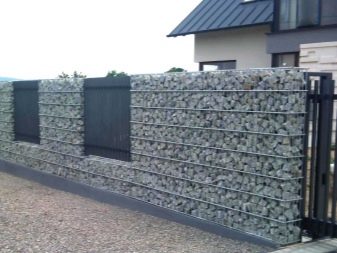
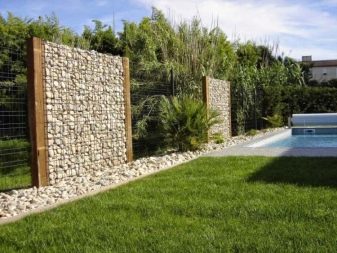

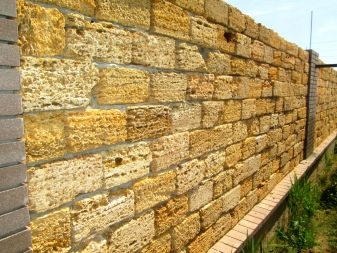
For construction, it is better to use material from the same batch, since mined from different layers differs in density and structure. This can make work difficult.
Not the most difficult task is the construction of a limestone fence. It, of course, requires physical effort and patience.The flagstone itself is called so because it is a stone slab. By their nature, they can consist of dolomite, sandstone, limestone and other rocks.
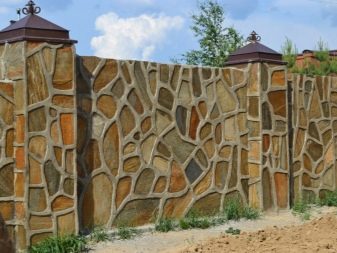
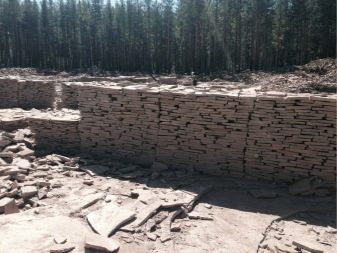
Decor
The decor of stone fences is set by the variety of textures of the selected material and the way the stone is processed. The designer will find a wide scope for creativity here. If the fence is made of natural stone, some kind of sandstone, in particular, shell rock, special design techniques may not be required. Natural stone itself is beautiful and does not contradict any landscape.
Certain types of stone can be used as a finishing material. For example, it is practiced to decorate chipped stone fences. In this case, the spans of the fence are made of concrete, and the stone is used outside for decoration.
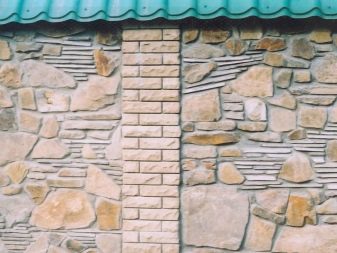

A stone fence with forged elements will look worthy. Forging can be used in the device of wickets and gates. The combination of metal and stone in this case will make a strong impression. And if forged elements are present on the building, which is surrounded by this fence, then the fence will fully fit into the overall design of the estate.
The combination of stone and wood looks stylish. This combination will lighten the structure and reduce the cost of creating a fence.
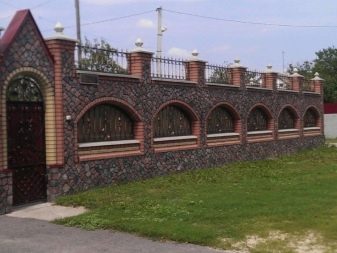
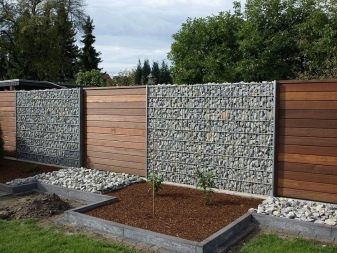
Professional advice
What kind of stone to use when building a fence for private estates, around residential buildings or institutions, depends only on the taste and wallet of the customer, who can choose the most expensive natural material or limit the use of artificial stone. Design techniques will help to make a semi-antique fence or give it an ultra-modern look.
It can be about an ordinary solid fence made of blocks or bulk structures that enclose the territory. Regardless of the details, there are work steps that cannot be skipped.
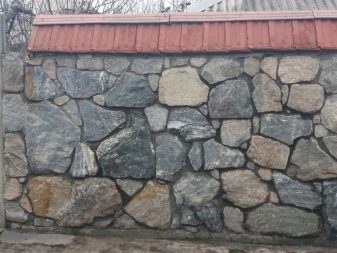

As professionals advise, before creating the foundation of the future fence, it is necessary to prepare a sketch of the fence and thoroughly study the territory on which the fence will be erected. The place under the future fence must be cleared, leveled and marked around the perimeter.
A stone fence requires a strip reinforced foundation. Its width is calculated so that it is fifteen centimeters wider than the fence itself. Also, the foundation should protrude ten to fifteen centimeters above ground level. This protruding part is called a plinth.
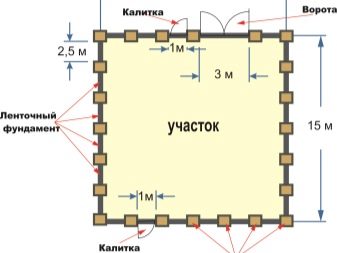

On difficult soils - watered or heaving - the depth of the foundation should not exceed the average depth of freezing in the area where the fence is supposed to be erected.
According to the markings, you need to dig a trench, fill it with sand - a layer of five centimeters will be enough. Then compact the sand properly.
Make the formwork. To do this, you can use boards or plywood that are at hand. After the installation of the formwork, reinforcement is laid on the compacted sand. For it, you can use rods eight millimeters thick. The foundation requires the device of two layers of the reinforcing frame. For reliability, these layers must be reinforced with vertical rods.
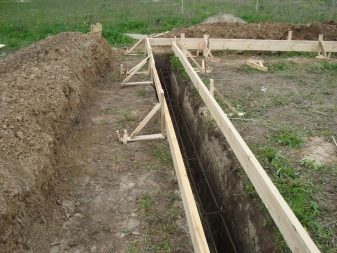
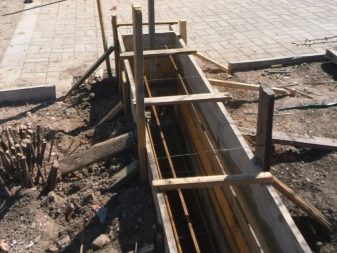
Along the way, pipes are also installed, which serve as the frame of the pillars. When the reinforcement is installed, the foundation is poured with concrete.
For greater strength of the foundation, you can waterproof it. Before pouring concrete, you need to line the bottom and walls of the trench with roofing material, and after the foundation has dried, this material is placed on top of the concrete tape.
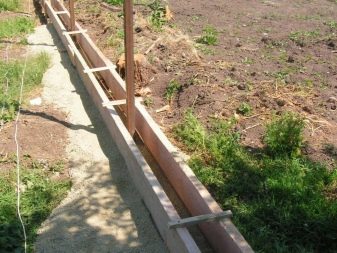
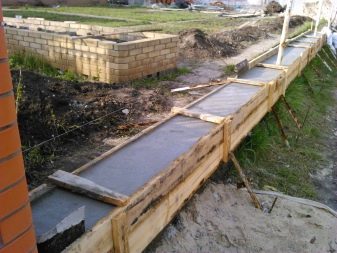
The stone laying technology will depend on what kind of specific breed you are dealing with. For example, sandstone or treated cobblestone can be laid like a brick. For rubble stone, the option using formwork is suitable.
So that the fence does not lose its beautiful appearance over time, you need to take care to close up all the seams. For joints that are too deep, additional mortar will have to be applied.
It is better to first clean the contaminated areas with a metal brush.
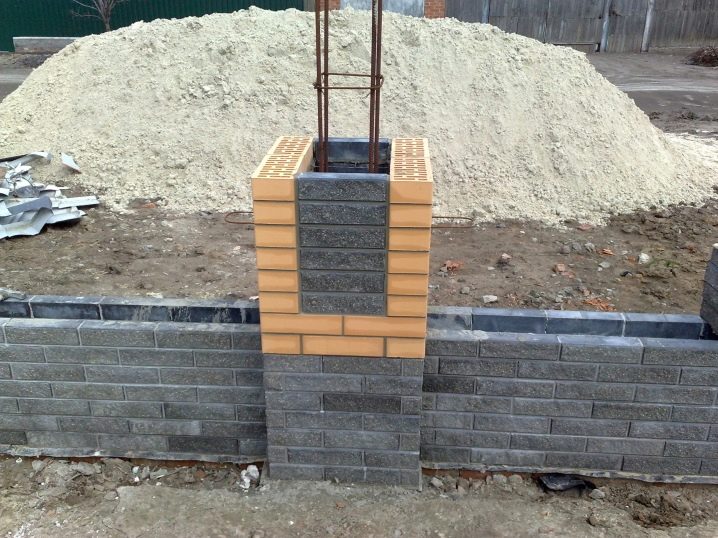
Beautiful options
Each stone fence is unique. The longer he “lives” in the world, the more he is filled with some special spirit associated with the place where he “grew up”. This is probably why it is simply impossible to walk past the stone fence and not experience any emotions.
- The fence, lined with different types of stone, with ornate metal decorations, acting as an additional lattice, will perfectly fit into the landscape around the country house, mentally sending back to the beginning of the XX century or to the end of the XIX century.
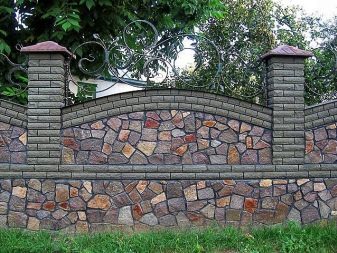
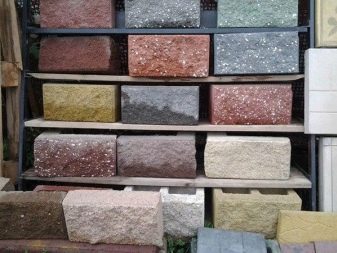
Such a fence will hide the privacy of homeowners from prying eyes. And thanks to the metal openwork decoration, the stone fence will not look heavy and menacing. Such a fence is interesting in itself, regardless of what is behind it. Even just taking a photo while walking past this fence will be nice.
- The combination of a rounded log with a stone finish, despite its simplicity, looks very stylish, suggesting a fortress wall in a medieval Russian city. You can feel safe behind such a fence.

- The lightness of the white wooden picket fence is balanced by the massive stone base of the fence. With an obvious difference in the properties of the texture of the selected materials, the fence has a respectable and austere look.
- Even a stone opens up a lot of space for a true designer's imagination. Using stones of different shapes and sizes, you can "paint" the whole picture on the fence. In this case, a tree appeared on it. Although another author could have "settled" some animal, bird on this wall, or "grown" a whole garden of stone flowers here. With the help of such a mosaic, you can give dynamism to even the most ordinary-looking stone.
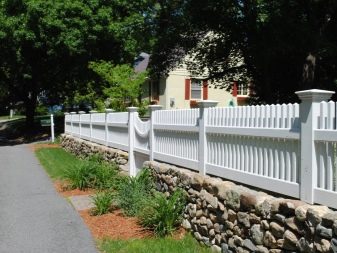

- A stone fence in combination with a wooden lattice, through which flowers have sprouted profusely, looks simply unforgettable. You want to stay behind such a reliable wall, enjoying nature and solitude.
- A fence made of casually folded stone gives an impression of strength and reliability. A cozy house with a garden behind such a fence will be perfectly protected not only from prying eyes, but also from the encroachments of those wishing to illegally penetrate such a fence.
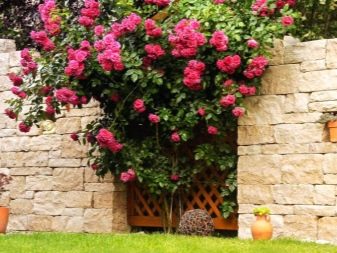
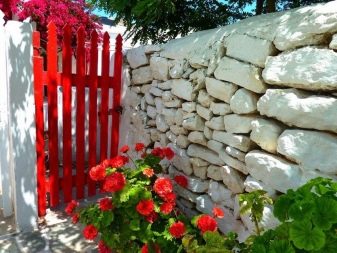
The combination with a wooden gate, painted in a bright color, and ordinary geraniums with lush flowers gives the fence an unsightly rustic look, but this only makes it dearer, it will be remembered for a long time by the viewer.
- A stone fence with an arch that invites into the garden is perceived as an integral part of the rich natural landscape hidden behind this heavy wall. At the same time, it seems that behind such a fence, undoubtedly, something mysterious and extraordinary awaits, causing a desire at all costs to go through the opening passage. Even a stone fence, seemingly devoid of grace, can be perceived as something romantic and fabulous.

How to make a stone fence quickly and beautifully, see the next video.



































































The comment was sent successfully.